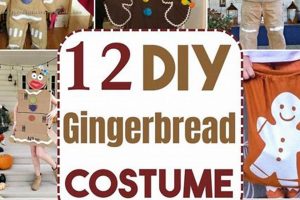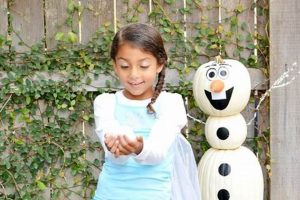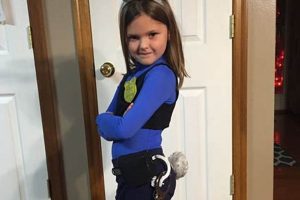Creating a handmade Jack Skellington-inspired outfit involves the independent construction of attire reminiscent of the iconic character from The Nightmare Before Christmas. This undertaking typically requires readily available materials, crafting skills, and a degree of imaginative design. For example, individuals might fashion a pinstripe suit from repurposed clothing or create the character’s distinctive skull head from paper mache.
The appeal of producing such an ensemble lies in its cost-effectiveness and the opportunity for personalization. It allows for a unique expression of fandom and a departure from commercially manufactured alternatives. Historically, self-made costumes have represented a resourceful approach to festive occasions, predating the mass production of character-themed apparel. This method fosters creativity and resourcefulness, offering a tangible connection to the subject matter.
The following sections will explore specific techniques for assembling the various components of this character-inspired attire, including methods for creating the suit, head, and makeup, providing detailed instructions and material suggestions for each aspect. The information is geared toward enabling individuals to successfully complete the project with varying levels of crafting experience.
Crafting a Jack Skellington-Inspired Ensemble
Constructing a successful handmade Jack Skellington-inspired outfit requires careful planning and execution. These tips provide guidance on key aspects of the process, ensuring a visually accurate and durable result.
Tip 1: Fabric Selection is Paramount: Opt for a tightly woven black fabric for the pinstripe suit. Consider gabardine or suiting material for durability and wrinkle resistance. Avoid flimsy fabrics that will not hold their shape.
Tip 2: Accurate Pinstripe Application: Employ thin white fabric paint or carefully applied white tape to create the pinstripes. Ensure the stripes are evenly spaced and consistently oriented for a professional appearance. Precise measurements are crucial.
Tip 3: Head Construction Considerations: When crafting the head, prioritize lightweight materials such as paper mache or foam. A heavy head will be uncomfortable to wear for extended periods. Proper ventilation is also essential.
Tip 4: Makeup Application Techniques: Use high-quality, professional-grade white face paint for the character’s complexion. Multiple thin layers are preferable to one thick layer to prevent cracking and smudging. Seal the makeup with a setting spray.
Tip 5: Bow Tie Proportions: The bow tie should be oversized and bat-shaped, adhering to the character’s distinctive design. Use stiff interfacing to maintain the bow’s shape and prevent drooping.
Tip 6: Bone Hand Detailing: If incorporating bone hands, use flexible materials like foam or rubber to allow for comfortable movement. Securely attach the bones to black gloves for a cohesive look.
Tip 7: Attention to Detail in Embellishments: Small details, such as adding a subtle black wash to the white makeup to create depth, can significantly enhance the overall effect. Consider the character’s subtle nuances.
Adhering to these guidelines will contribute to the creation of a visually striking and comfortable handmade Jack Skellington-inspired outfit, suitable for a variety of occasions. Careful attention to detail elevates the final product.
The next section will address common challenges encountered during the creation process and offer solutions for overcoming them, ensuring a smooth and successful project outcome.
1. Fabric Selection
Fabric selection is a foundational element in the creation of a Jack Skellington-inspired attire. The choice of material directly impacts the garment’s appearance, durability, and comfort. Inappropriate material choices can result in a costume that lacks visual authenticity or is uncomfortable to wear. For instance, using a sheer or lightweight fabric for the pinstripe suit may cause it to appear flimsy and ill-defined, detracting from the character’s sharp, tailored look. Conversely, a heavy, stiff fabric could restrict movement and create an unnatural silhouette.
The selection process necessitates careful consideration of several factors. The fabric’s weight, texture, and drape should align with the desired aesthetic. A tightly woven suiting fabric, such as gabardine or a wool blend, is often favored for its ability to hold its shape and provide a structured appearance. The fabric’s color and its ability to accept embellishments, such as pinstripes, are also critical. For example, applying paint or tape pinstripes to a heavily textured fabric may prove difficult, leading to uneven lines and a less polished final product. Historical examples of costume construction emphasize the use of appropriate materials to achieve a believable and enduring result, highlighting the practical significance of informed fabric selection.
Ultimately, the fabric selection stage influences the overall success of the independent creation process. Inadequate fabric choices can lead to aesthetic compromises, structural instability, or reduced wearer comfort. This initial decision serves as a critical foundation upon which the rest of the costume construction is built. A careful and informed approach to fabric selection is therefore essential for achieving a satisfying and visually compelling Jack Skellington-inspired attire.
2. Head construction
Head construction is a pivotal element in the successful creation of a Jack Skellington-inspired attire. The character’s distinctive skull is immediately recognizable, and an accurately rendered headpiece significantly enhances the overall impression. Improper construction can result in a distorted or disproportionate head, diminishing the costume’s authenticity. For instance, a head that is too small or lacks the character’s elongated features would detract from the intended effect. A flimsy or poorly supported structure could collapse or deform during wear, compromising the visual impact.
Several factors contribute to successful head construction. Material selection plays a crucial role, with lightweight options like paper mache or foam being preferred to minimize wearer fatigue. The structural integrity of the headpiece is equally important, requiring a sturdy internal frame to maintain its shape. Ventilation is a practical consideration, as an enclosed head can quickly become uncomfortable due to heat and humidity. Examples of successful head construction include using wire mesh to create a lightweight yet durable frame, or incorporating hidden fans to improve airflow. Attention to detail, such as accurately sculpting the facial features and ensuring proper proportions, elevates the quality of the finished product. Neglecting these elements can lead to a headpiece that is visually unapp
ealing or functionally inadequate.
In conclusion, head construction represents a critical aspect of independently creating a Jack Skellington-inspired attire. The successful execution of this element significantly contributes to the costume’s overall effectiveness and wearer comfort. Challenges in head construction can range from material selection to structural integrity, but addressing these issues through careful planning and execution is essential for achieving a visually accurate and functionally sound result. The headpiece serves as the focal point of the ensemble, making its proper construction a defining factor in the costume’s success.
3. Pinstripe precision
Pinstripe precision is a critical aspect of constructing a successful handmade Jack Skellington attire. The character’s signature pinstripe suit is a defining visual element, and accurately replicating this detail significantly contributes to the costume’s overall authenticity. Deviations from the intended pattern or sloppy application can detract from the desired aesthetic, resulting in a less convincing portrayal of the character.
- Pinstripe Spacing and Width
Maintaining consistent spacing and width between the pinstripes is essential for achieving a professional appearance. Uneven or inconsistent stripes can create a visually jarring effect and detract from the costume’s overall polish. For example, if the pinstripes vary in width, the suit may appear asymmetrical or haphazardly constructed. Precision in measurement and application is paramount for replicating the character’s refined look.
- Pinstripe Orientation and Alignment
The pinstripes must be perfectly vertical and aligned throughout the suit. Angled or misaligned stripes can distort the garment’s appearance and create a sense of visual imbalance. Real-world examples of tailoring demonstrate the importance of accurate alignment in achieving a well-constructed garment. In the context of a self-made Jack Skellington suit, careful attention to orientation and alignment elevates the costume from a simple project to a detailed recreation.
- Pinstripe Application Technique
The method used to apply the pinstripes directly influences their appearance and durability. Options include fabric paint, adhesive tape, or even sewn-on ribbons. Each technique presents its own challenges and advantages. Fabric paint requires a steady hand and careful application to prevent bleeding or smudging, while tape must be applied smoothly and securely to avoid peeling or bubbling. The chosen technique should result in clean, crisp lines that withstand wear and movement.
- Color Contrast and Sharpness
The contrast between the black suit fabric and the white pinstripes should be sharp and distinct. Faded or poorly defined stripes can diminish the visual impact of the costume. Selecting high-quality materials and employing appropriate application techniques are crucial for achieving the desired level of contrast. Consider, for instance, the difference between using a diluted fabric paint versus a highly pigmented one; the latter will produce a more vibrant and lasting result, directly affecting the costume’s overall visual appeal.
In conclusion, pinstripe precision is not merely an aesthetic detail but a fundamental aspect of a successful handmade Jack Skellington attire. By paying close attention to spacing, width, orientation, application technique, and color contrast, the creator can elevate the costume from a simple imitation to a compelling and recognizable representation of the character.
4. Makeup Application
The application of makeup is intrinsically linked to the successful creation of a Jack Skellington-inspired attire. This costume, being a depiction of an animated character, relies heavily on makeup to bridge the gap between human appearance and the character’s stylized features. Inadequate makeup application directly impacts the authenticity and recognizability of the completed costume. The character’s stark white face, hollow black eyes, and skeletal grin are achieved primarily through makeup techniques, thus making it an indispensable component.
The specific techniques employed in the makeup application are critical. Achieving a uniform, opaque white base requires layering professional-grade face paint, carefully avoiding streaks or patchiness. The hollowed-out eyes necessitate precision in shading and blending, creating the illusion of depth. Replicating the skeletal grin involves precise linework and an understanding of facial anatomy. Failure to execute these techniques correctly results in a costume that lacks visual fidelity. For example, using low-quality face paint can lead to uneven coverage and rapid fading, while imprecise linework can distort the character’s iconic smile. Real-life examples of successful character portrayals consistently highlight the importance of professional-level makeup skills. Consider the makeup artists who create characters for stage productions or theme parks. These professionals invest significant time and resources into mastering makeup techniques to ensure accurate and convincing representations.
In summary, makeup application is not merely an optional accessory but a foundational element in realizing a convincing Jack Skellington-inspired look. The techniques required demand precision, skill, and high-quality materials. Challenges in makeup application, such as achieving a smooth white base or accurately replicating the skeletal features, must be addressed to elevate the costume from amateurish to professional quality. The makeup’s role extends beyond mere aesthetics; it is integral to embodying the character’s essence and ensuring the costume’s overall impact.
5. Bow tie shape
The bow tie shape serves as a defining characteristic of a handmade Jack Skellington-inspired attire, functioning as a critical visual cue that contributes significantly to the overall recognizability of the costume. A deviation from the character’s distinct bat-shaped bow tie diminishes the immediate association with the source material, thereby reducing the costume’s impact. The bow tie, while seemingly a small detail, acts as a concentrated symbol of the character’s unique aesthetic. Its distinct shape contrasts sharply with conventional bow tie designs, reinforcing the character’s unconventional and whimsical nature. Consider, for example, a scenario where an individual constructs a highly detailed Jack Skellington suit but utilizes a standard bow tie shape; the immediate impression would be weakened, and the costume might be misconstrued as simply a formal black and white ensemble. The cause and effect are clear: an accurate bow tie shape reinforces the character portrayal, while an inaccurate one detracts from it.
Achieving the correct bow tie shape necessitates careful attention to pattern design and construction techniques. The bat-wing silhouette requires precise cutting and shaping of the chosen fabric. Stiff interfacing is often employed to provide structure and prevent the bow tie from collapsing or losing its form. The size and proportions must also align with the character’s canonical design; an excessively
large or small bow tie would disrupt the costume’s visual balance. Practical applications of this understanding extend to the creation of patterns and tutorials specifically tailored for constructing a Jack Skellington bow tie. These resources emphasize the importance of accurate measurements, clear instructions, and appropriate material selection. Furthermore, costume contests and cosplay events often reward accuracy and attention to detail, placing a premium on replicating the bow tie shape faithfully.
In summary, the bow tie shape represents a key detail in a handmade Jack Skellington-inspired attire, acting as a visual shorthand for the character and significantly influencing the costume’s overall effectiveness. Challenges in accurately replicating the shape, such as achieving the correct proportions or maintaining structural integrity, must be addressed to produce a convincing portrayal. Understanding the practical significance of this seemingly minor detail is crucial for elevating the costume from a generic black and white outfit to a recognizable representation of the iconic character. Therefore, the construction of an accurate bow tie is an essential element in the successful execution of this specific costume project.
6. Bone hand detail
The inclusion of bone hand detail is a significant factor in the creation of a visually accurate and compelling homemade Jack Skellington costume. The character’s skeletal appearance extends to his hands, making this detail a recognizable and impactful element of the overall design. Its absence or inaccurate execution detracts from the costume’s fidelity to the source material.
- Material Selection and Construction
The choice of materials for the bone hands impacts both their visual appearance and wearer comfort. Rigid materials, while potentially more accurate in form, may restrict movement. Flexible materials like foam or rubber provide greater dexterity but require careful sculpting to maintain a realistic skeletal appearance. For example, a costume incorporating bone hands constructed from craft foam and attached to black gloves offers a balance between realism and practicality. The method of attachment is also crucial, ensuring the bone segments are securely fastened while allowing for hand articulation.
- Anatomical Accuracy
While a cartoon character, Jack Skellington’s design incorporates elements of skeletal anatomy. The accurate representation of bone shapes and proportions enhances the costume’s realism. Simplified, abstract representations may be easier to construct but sacrifice visual impact. A costume featuring hands with properly shaped phalanges and metacarpals, even if stylized, conveys a more sophisticated understanding of the character’s design than one with rudimentary bone shapes.
- Integration with Gloves
Bone hands are typically integrated with gloves to create the illusion of skeletal hands. The choice of glove material and color is crucial for seamless integration. Black gloves provide a neutral backdrop, allowing the bone details to stand out. The method of attachment must be secure to prevent the bone elements from detaching during wear. A poorly integrated bone hand can disrupt the costume’s visual flow and detract from its overall impact.
- Artistic Interpretation and Stylization
While accuracy is important, scope exist for personal interpretation and stylization in crafting the bone hands. Applying aging or weathering techniques to the bones can add depth and visual interest. Employing different sculpting methods can create a unique aesthetic. For example, some costume creators might opt for a more cartoonish or exaggerated bone shape, while others might strive for a hyper-realistic depiction. This artistic freedom allows for a personalized interpretation of the character while still maintaining the core visual elements.
These facets underscore the importance of carefully considering the construction, anatomical accuracy, and integration of bone hand details when creating a homemade Jack Skellington costume. The quality and execution of these elements contribute significantly to the overall success and visual impact of the final product. The bone hands, therefore, serve as a key indicator of the creator’s attention to detail and understanding of the character’s design.
Frequently Asked Questions
The following section addresses common inquiries regarding the creation of a homemade Jack Skellington costume. The responses aim to provide clarity on various aspects of the construction process, offering guidance to individuals undertaking this project.
Question 1: What is the recommended method for creating accurate pinstripes on the suit?
Achieving precise pinstripes involves several techniques. Fabric paint, applied with a thin brush and a steady hand, is one option. Alternatively, narrow strips of white fabric tape can be affixed to the black suit material. Stencil techniques, using a custom-cut stencil and fabric paint, provide a repeatable pattern. The chosen method should prioritize accuracy and durability.
Question 2: What are the primary considerations when constructing the headpiece?
Headpiece construction necessitates attention to weight, structural integrity, and ventilation. Lightweight materials such as paper mache or foam are preferable. A sturdy internal frame ensures the headpiece retains its shape. Adequate ventilation prevents overheating and discomfort. The headpiece’s design should also accurately reflect the character’s distinct skull shape.
Question 3: What type of makeup is best suited for achieving Jack Skellington’s complexion?
Professional-grade, water-activated face paint is recommended for creating the stark white complexion. Multiple thin layers provide more uniform coverage than a single thick layer, minimizing cracking and smudging. A setting spray helps to prolong the makeup’s wear time and prevent transfer. Avoid oil-based products, as these may interact negatively with the fabric of the costume.
Question 4: How can the bat-shaped bow tie maintain its form?
Maintaining the bow tie’s shape requires the use of stiff interfacing. This material, when fused or sewn to the fabric, provides the necessary support. The pattern should accurately reflect the bat-wing silhouette. Precise cutting and sewing techniques are essential for achieving a clean, defined shape. Alternative materials include buckram or heavy felt.
Question 5: What are the options for creating articulated bone hands?
Articulated bone hands can be constructed from various materials, including foam, rubber, or molded plastic. Each bone segment is individually sculpted and then connected using flexible joints, such as wire or elastic. Attaching these segments to black gloves creates a complete hand. Anatomical accuracy enhances the realism of the bone hands.
Question 6: What strategies can be used to minimize costume discomfort during extended wear?
Minimizing discomfort involves careful material selection and construction techniques. Lightweight, breathable fabrics reduce overheating. Padding in areas of friction prevents chafing. A well-fitted underlayer absorbs moisture. Regularly scheduled breaks allow for ventilation and movement. Attention to these details enhances the overall wearer experience.
In summary, successfully constructing a Jack Skellington-inspired attire requires attention to detail, appropriate material
selection, and skillful execution of various techniques. Adhering to these guidelines increases the likelihood of a visually compelling and comfortable outcome.
The subsequent section will explore advanced techniques for embellishing and customizing the Jack Skellington-inspired attire, providing options for individuals seeking to further enhance their creations.
DIY Jack Skellington Costume
This exploration of diy jack skellington costume construction has illuminated critical elements for successful creation. Fabric selection, head construction, pinstripe precision, makeup application, bow tie shape, and bone hand detail have been identified as key areas demanding careful consideration. The intricacies of each component significantly impact the final product’s visual accuracy and overall effectiveness.
The independent construction of a Jack Skellington-inspired attire represents a commitment to detail and a dedication to realizing a recognizable character representation. It challenges creators to apply diverse crafting skills and emphasizes the value of meticulous execution. Continued refinement of techniques and adherence to established principles promise to enhance future iterations of this endeavor, fostering a deeper appreciation for both the character and the artistry involved.







